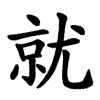就
- to go toward;
- to reach;
- to proceed to;
- to accomplish;
Etymology
就 is a compound ideograph formed from:
京 (서울 경) — representing a tall building or elevated structure, symbolizing height or eminence.
尤 (더욱 우) — meaning especially, exceedingly, indicating intensity or emphasis.
Together, they depict the act of ascending toward something outstanding or elevated — hence “to approach, to go to, to reach.”
The Shuowen Jiezi (說文解字) glosses it as “高也” (“high”) — referring metaphorically to rising toward a higher place or position.
Later, its semantic range broadened from physical approach to achievement, success, and immediacy, explaining its later adverbial meanings like “then” or “right away.”
Usage in Korean
就職 (취직) — to take a job, employment
就學 (취학) — to go to school, to enroll
就座 (취좌) — to take one’s seat
成就 (성취) — achievement, accomplishment
就算 (취산) — even if; suppose that
就此 (취차) — at this point; thus
Words that derived from 就
Additional notes
In classical Chinese, 就 often described approaching a goal or attaining a position — e.g., 就事 (“to undertake an affair”), 就位 (“to take one’s post”).
Thus, it symbolized progress through action, the movement from intention to realization — a key virtue in Confucian pragmatism.
Already in pre-Qin literature, 就 functioned as a temporal or consequential adverb:
乃就之 — “then approached it.”
遂就成功 — “thus achieved success.”
This developed into its modern sense of “then / immediately / precisely.”
Philosophically, 就 reflects self-direction and initiative — the act of aligning one’s conduct with purpose.
It stands opposite to 退 (to withdraw), marking the ethical principle of advancement toward virtue or goal (就義, 就學, 就道).
Modern language and grammar:
In Mandarin and Korean Sino-words alike, 就 is one of the most frequent grammatical adverbs:
我一到家就睡覺 - (“As soon as I got home, I went to sleep.”)
就這樣 - (“Just like this.”)
這件事就算了 - (“Let’s just forget it.”)
Its conciseness and flexibility make it a bridge word expressing immediacy, emphasis, or logical transition.
- 卜火戈大山 (YFIKU)
- ⿰ 京 尤
